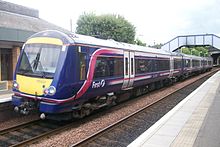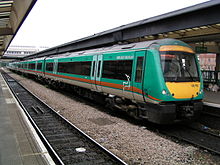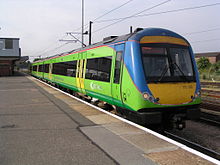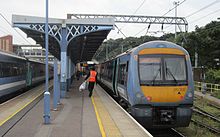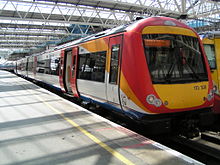- British Rail Class 170
-
British Rail Class 170 Turbostar 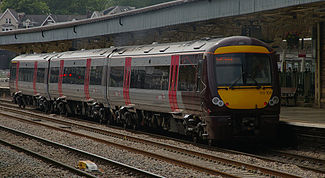
CrossCountry 170104 at NewportIn service 1998 - Present Manufacturer ADtranz / Bombardier Family name Turbostar Constructed 1998 - 2005 Number built 122 trainsets Formation 2 or 3 cars per trainset Operator CrossCountry
First ScotRail
First TransPennine Express
London Midland
National Express East AngliaSpecifications Car body construction Welded aluminium. Steel ends. Train length 2 car: 47.22 m (154 ft 11 in) Car length 23.62 m (77 ft 6 in) Width 2.69 m (8 ft 10 in) Height 3.77 m (12 ft 4 in) Maximum speed 100 mph (160 km/h) Weight Varies between 90.41 t (170/1 2 car) to 135.31 t (170/1 3 car) Engine(s) One MTU 6R 183TD13H diesel per car Power output 315 kilowatts (422 hp) at 1,900 rpm Transmission Voith Hydraulic T211rzze to ZF final drive
2 axles driven per carBogies Powered: BREL P3-23 Unpowered: BREL T3-23 Braking system(s) Disc brakes Safety system(s) AWS, TPWS Coupling system BSI[1] Gauge 1,435 mm (4 ft 8 1⁄2 in) Standard gauge The Class 170 "Turbostar" is a British diesel multiple-unit (DMU) train built by Bombardier Transportation (and previously ADtranz) at its Derby Litchurch Lane Works. Introduced after privatisation, they have operated as regional trains as well as long-distance trains, and to a lesser extent suburban trains. 122 units have been built.
Contents
Design
The class are a development of the design used in the British Rail Class 165, 166 and 168 DMUs known as the Networker Turbos which were built by BREL and later ABB Transportation Ltd before that company eventually became part of Bombardier.
Notable features shared are the aluminium alloy frame and Voith transmission as well as the general body shape (the cab ends are similar to those of the Class 168, but not Class 165/166), interior design and door fittings. The final drive is sourced from ZF instead of Gmeinder and the diesel engine supplier has changed to MTU.[2]
The engine and transmission are under the body; one bogie per coach is powered, the other unpowered. All coaches in the set are powered (there are no unpowered trailers). The units can work in multiple with British Rail Classes in the 15X series, i.e. Sprinters, and with other units of the same class. They are unable to operate in multiple with units in the 16X series due to different wiring arrangements.[3]
Seating arrangements are of both 2+1 (first class) and 2+2 (standard class) formation, and give a seated passenger capacity of between ~100 and ~200 per three-car set (depending on the specifications of the operator).[4] 2-car sets are also operated.
Subclasses
Class 170 units have been categorised into six sub-classes; the basic specifications remain the same (engine, length, transmission, etc.), the differences being the seating arrangements specified by the different operators. Because of the different interior fittings the sub-classes differ in weight from one another by a small amount, up to ~2 tonnes.[3]
All the subclasses were built at Derby works either under ADtranz or Bombardier Transportation's ownership.[3]
Operations
Scotland
Edinburgh bound Class 170 at Falkirk High railway station, August 2010
First ScotRail is the largest operator of the Class 170, with a fleet comprising 59 3-car sets. Originally, 34 of these had First Class accommodation. They are mainly used on Edinburgh-Glasgow (Queen Street), Inverness-Glasgow/Edinburgh and Aberdeen-Glasgow/Edinburgh services.
An additional nine units were ordered and operated by Strathclyde Partnership for Transport (SPT) and were painted in the Strathclyde maroon and cream livery; these units now operate under the direction of Transport Scotland, which has authority over the entire ScotRail area.
Additionally, four 3-car sets fitted with 'mini-buffets' were obtained from Hull Trains, also containing First Class accommodation and are regularly rostered to work longer distance services, particularly to the north. When working on a diagram without First Class provision (at the discretion of the on-train staff), the First Class areas may be declassified.
All units (including SPT liveried examples) are allocated to Edinburgh's Haymarket depot.
In September 2008 the Scottish Government's agency Transport Scotland announced that all ScotRail trains (including from the Strathclyde Partnership for Transport) would be eventually repainted in a new, blue livery with white Saltire markings on the carriage ends.[5] The first unit to get the livery was 170434, which was unveiled to the public at Glasgow Queen Street on 22 September 2008.
In December 2008, half of the Standard Class only units, 170450 - 170455, were fitted with First Class sections.
Northern England
First TransPennine Express operate nine Class 170s, used on the Manchester to Hull route. Originally Class 185s were set to operate the route but a combination of weight restriction problems on the Selby to Hull line and the government reducing the amount of money available to First Transpennine Express for new trains resulted in Class 170s coming into service.
From 9 September 2009, two Class 170s are used Sundays to Thursdays on the Cleethorpes-Manchester Airport service.
First TransPennine Express received eight Turbostars from South West Trains, 170 301-170 308 at the end of 2006 and the start of 2007, as well as 170 399 from Central Trains in November 2007 which was re-numbered to 170 309.
The units are maintained by Bombardier Crofton. The 170s have since been fully refurbished to include CCTV, power sockets throughout, replacement carpets and seat covers and the removal / declassification of one of the two first class sections, providing more seats. The work was carried out by Transys at Clacton-on-Sea.
Hull Trains
Hull Trains began its London King's Cross to Hull services using Turbostars, initially with four sets on short-term lease from Anglia Railways. In 2004, it received four of its own 3 car Class 170/3 units, and returned the original units to Anglia.
In 2005, following its acquisition by FirstGroup, Hull Trains received four new Class 222/1 "Pioneer" units and transferred the Turbostars to its sister company First ScotRail.
The Midlands
Midland Mainline Class 170/1, nos. 170 110 and 170 117 at Derby on 18 September 2003, during service to London St. Pancras
Midland Mainline (MML) was the first operator to order Turbostars, with the first being introduced in MML's green and tangerine livery in 1998. The Class 170/1 were built immediately after the Class 168/0 for Chiltern Railways were built. MML ordered a fleet of seventeen 2-car Class 170/1 units, although the first ten were subsequently made-up to 3-cars. The units were introduced on stopping services from London St. Pancras to Leicester, Derby and Nottingham. Some units were also used on summer Saturday only services from the capital to York, which later became a year round service with summer extension to Scarborough.
Central Trains had a fleet of 53 Class 170 units from various subclasses.
In 1999, Central received its first batch of twenty-three 2-car Class 170/5 and ten 3-car Class 170/6 units. These were used to replace Class 156 units on long distance "Citylink" services. These units all carried the Central Trains livery of green, blue and yellow.
From late 2004, Central also took three Class 170/3 on lease from Porterbrook. Units 170 397 and 170 398 are 3-car units and 170 399 is a 2-car unit. The units originally carried a white livery with purple doors (the house colours of owners Porterbrook). All three of these units contained First Class accommodation which was declassified (allowing Standard Class use throughout the train) as First Class travel was not provided on Central Trains services. The two 3 car units interiors were of Central Trains style, except the MML style first class, and the 2 car unit had a South West Trains interior.
In 2004, Midland Mainline introduced new Class 222 "Meridian" units, which started to replace the Turbostars, as a result the fleet was transferred to former National Express Group franchise Central Trains. Ten units (170 101-110) are 3-car units, with the remaining seven units (170 111-117) being 2-car units. As with the three spot-hire units from Porterbrook these 17 units had first class accommodation, which was declassified.
All Class 170 units which were in service with Central were used on a variety of services (mostly long distance) including:
- "Citylink" services
- Birmingham-Stansted Airport
- Norwich-Liverpool
- Nottingham-Cardiff
- Birmingham to Leicester
- Derby to Matlock
- Derby to Crewe
- Leicester to Lincoln Central
- Nottingham to Worksop
- Nottingham to Skegness
Class 170 units have been replaced by Class 350 "Desiro" units on Birmingham-Liverpool services.
When Central Trains lost its franchise in 2007, 23 of Central Trains' units were transferred to London Midland which took over the West Midlands franchise and continues to use Class 170s on these workings. 29 out of the other 30 (including all the ex-Midland Mainline units, and two of the 3 spot hire units) were transferred to CrossCountry and are used on mainly shorter distance services in the Midlands such as Cardiff - Nottingham, Birmingham - Stansted Airport and Leicester-Birmingham. One of Central Trains' 170s (170399) went to First Transpennine Express; East Midlands Trains did not receive any despite taking over the previously Class 170 operated Liverpool to Norwich route.
London Midland has ordered more Turbostars for use on the Snow Hill Lines; these will be Class 172 units, which are a development of the Class 170 design. They are expected to be operating by summer 2010.[6]
Eastern England
Anglia Railways ordered two batches of Turbostars. The first batch of eight 3-car Class 170/2 units were built for London Liverpool Street to Ipswich, Norwich, Lowestoft and Bury St. Edmunds services. These supplemented the existing Class 86 locomotive-hauled trains from London to Norwich. Four of these units were later hired to Hull Trains from 2002–2004, before they acquired their own Turbostars.
Other units, including the spot-hire set no. 170 399, were used on Anglia's short-lived Norwich to Basingstoke ‘London Crosslink’ service. In 2002, Anglia introduced a new Cambridge to Norwich direct service, and acquired four two-carriage units dedicated to working these services.
In 2004 the Greater Anglia franchise was won by the National Express Group subsidiary 'one', (since rebranded as National Express East Anglia). Since then, two-carriage Turbostars have been used for the Cambridge to Norwich route, and also on new through services including Peterborough and Lowestoft to London Liverpool Street via Ipswich, although with a new timetable all Class 170 London services have ended, in favour of conneting branch line trains with GEML expresses.
The three-carriage trains used to include a buffet and larger First Class area, but because more seating was needed, the buffet area has been replaced and the number of First Class seats reduced.
South-West England
South West Trains 170 308 at London Waterloo
South West Trains (SWT) acquired a fleet of eight 2-car Class 170/3 units in 2000, to supplement its existing Class 159 fleet. Units operated on London Waterloo to Salisbury, Reading to Brighton, Southampton local trains and occasionally on Exeter services.
All of these units were transferred to TransPennine Express at the end of 2006.
Southern Region of England
Southern obtained six 2-car Class 170/7 units, along with six 4-car Class 171/8 units, in 2003 to replace its aging Class 205 and Class 207 units on services on the Marshlink Line and Oxted Line to Uckfield.
Southern later fitted these units with the Dellner type coupler used on its Class 171s, reclassifying its two car units as Class 171/7 replacing the standard BSI coupler fitted to Class 170s.
Current fleet details
Class Operator No. Built Year Built Cars per Set Unit nos. Class 170/1 CrossCountry 17 1998–1999 3 170 101 - 170 110[7] 2 170 111 - 170 117[7] Class 170/2 National Express East Anglia 12 1999 3 170 201 - 170 208[7] 2002 2 170 270 - 170 273[7] Class 170/3 First TransPennine Express 9 2000 2 170 301 - 170 309[7] First ScotRail 4 2004 3 170 393 - 170 396[7] CrossCountry 2 2002 3 170 397 - 170 398[7] Class 170/4 First ScotRail 24 1999–2001 3 170 401 - 170 424[7] 10 2003–2004 3 170 425 - 170 434 12 2004–2005 3 170 450 - 170 461[7] 2 2001 3 170 470 - 170 471[7] 7 2004 3 170 472 - 170 478[7] Class 170/5 London Midland 17 1999–2000 2 170 501 - 170 517[7] CrossCountry 6 1999–2000 2 170 518 - 170 523 Class 170/6 London Midland 6 2000 3 170 630 - 170 635[7] CrossCountry 4 2000 3 170 636 - 170 639[7] References
- ^ "Mechanical And Electrical Coupling Index". Rail Safety and Standards Board. http://www.rssb.co.uk/RGS/Pages/MECHANICALANDELECTRICALCOUPLINGINDEX.aspx. Retrieved 2010-12-20.
- ^ TURBOSTAR - United Kingdom bombardier.com
- ^ a b c CLASS 170 'Turbostar' therailwaycentre.com
- ^ TURBOSTAR - United Kingdom - technical data - bombardier.com
- ^ transportscotland.com - New Scottish livery
- ^ "Bombardier to supply 69 Turbostar cars to Porterbrook Leasing in 129 million euro contract for the UK" (Press release). Porterbrook. 2007-12-13. http://www.porterbrook.com/pages/press_releases/131207.html. Retrieved 2008-07-05.
- ^ a b c d e f g h i j k l m n Clinnick, Richard (2009). "Britain's future-facing fleets". Rail (634): 66–73.
External links
Bombardier Turbostar and Electrostar family Turbostar family: Electrostar family: Diesel multiple units of the United Kingdom First generation units: First Generation
Original TOPS:First generation units
(pre-TOPS):British United Traction · Derby Lightweight · Metro-Cammell · Railbus · GWR Railcars · LMS Railcars
Second generation units: Diesel-electric units: Southern Railway designations: Families Categories:- Bombardier multiple units
- Adtranz multiple units
- British Rail diesel multiple units
Wikimedia Foundation. 2010.


